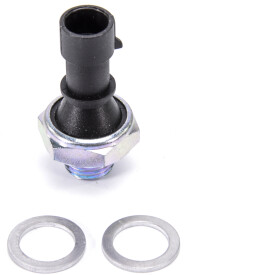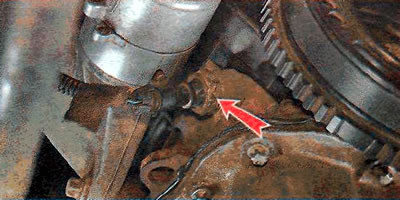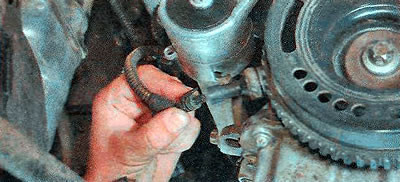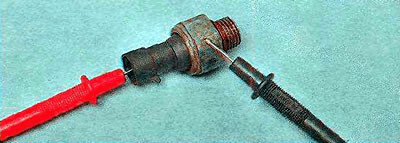
Oil pressure sensor Opel Zafira
Content
Emergency oil pressure sensor - check and replace
The emergency oil pressure sensor is screwed into the oil pump housing next to the crankshaft pulley.

The operation is shown on the example of replacing a 1.6 DOHC engine sensor. On other engines, the operation is performed similarly.
You will need a multimeter to work.
Sequence of execution
Disconnect the sensor harness connector.

We connect the multimeter in the dialing mode to the output and the sensor housing. The circuit must be closed. Otherwise, the sensor must be replaced.
Warning! Disconnecting the sensor may spill a small amount of engine oil. After installing the sensor, check the oil level and top up if necessary.
Turn the sensor with a 24 mm wrench and remove it.

We connect the multimeter to the case and the output of the sensor in the continuity mode. Push the piston through the hole at the end of the sensor. The circuit should open. Otherwise, the sensor is defective and must be replaced.

Install the sensor in the reverse order.
Opel Zafira 1.8 (B) 5dv minivan, 140 HP, 5MT, 2005 – 2008 - insufficient oil pressure
Insufficient oil pressure (low oil pressure warning light on)
| List of possible faults | Diagnosis | Removal methods |
|---|---|---|
| Low engine oil level | According to the oil level indicator | Add oil |
| Defective oil filter | Replace the filter with a good one | Replace defective oil filter |
| Accessory drive pulley bolt loose | Check bolt tightness | Tighten the screw to the prescribed torque |
| Clogged mesh of the oil receiver | Inspection | clear grid |
| Displaced and clogged oil pump relief valve or weak valve spring | Inspection when disassembling the oil pump | Clean or replace faulty relief valve. Replace pump |
| Oil pump gear wear | Determined by measuring parts after disassembling the oil pump (at the service station) | Replace oil pump |
| Excessive clearance between bearing shells and crankshaft journals | Determined by measuring parts after disassembling the oil pump (at the service station) | Replace worn liners. Replace or repair crankshaft if necessary |
| Faulty low oil pressure sensor | We unscrewed the low oil pressure sensor from the hole in the cylinder head and installed a known-good sensor in its place. If at the same time the indicator goes out when the engine is running, the reverse sensor is faulty | Replace faulty low oil pressure sensor |
Reasons for drop in oil pressure
There is a light on the instrument panel that indicates emergency oil pressure in the engine. When it lights up, this is a clear sign of a malfunction. We will tell you what to do if the oil pressure lamp lights up and how to fix the problem.
The oil level indicator may come on for two reasons: low oil pressure or low oil level. But what exactly the oil light on the dashboard means, only the instruction manual will help you find out. We are helped by the fact that, as a rule, economy cars do not have a low oil level indicator, but only low oil pressure.
Insufficient oil pressure
If the oil lamp lights up, it means that the oil pressure in the engine is insufficient. As a rule, it lights up only for a few seconds and does not pose a particular threat to the engine. For example, it can ignite when the car is strongly rocked in a turn or during a cold start in winter.
If the low oil pressure light comes on due to a low oil level, then this level is usually already critically low. The first thing to do when the oil pressure light comes on is to check the engine oil. If the oil level is below normal, this is the reason that this lamp lights up. This problem is solved simply - you need to add oil to the desired level. If the light goes out, we rejoice, and do not forget to add oil in time, otherwise it can turn into serious problems.
If the oil pressure light is on, but the oil level on the dipstick is normal, then another reason why the light could light up is a malfunction of the oil pump. It does not cope with its task of circulating a sufficient amount of oil in the engine lubrication system.
In any case, if the oil pressure or low oil level light comes on, the vehicle should be stopped immediately by pulling to the side of the road or to a safer and quieter place. Why should you stop right now? Because if the oil in the engine is very dry, the latter can stop and fail with the prospect of a very expensive repair. Don't forget that oil is very important to keep your engine running. Without oil, the engine will fail very quickly, sometimes within a few minutes of operation.
Also, this situation occurs when replacing engine oil with a new one. After the first start, the oil pressure light may come on. If the oil is of good quality, it should go out after 10-20 seconds. If it does not go out, the cause is a faulty or non-working oil filter. It needs to be replaced with a new quality one.
Faulty oil pressure sensor
The oil pressure at idle (about 800 - 900 rpm) must be at least 0,5 kgf / cm2. Sensors for measuring emergency oil pressure come with a different response range: from 0,4 to 0,8 kgf / cm2. If a sensor with a response value of 0,7 kgf / cm2 is installed in the car, then even at 0,6 kgf / cm2 it will turn on a warning light indicating some emergency oil pressure in the engine.
To understand whether the oil pressure sensor in the bulb is to blame or not, you need to increase the crankshaft speed to 1000 rpm at idle. If the lamp goes out, the engine oil pressure is normal. Otherwise, you need to contact specialists who will measure the oil pressure with a pressure gauge, connecting it instead of the sensor.
Cleaning helps from false positives of the sensor. It must be unscrewed and all oil channels thoroughly cleaned, because clogging can be the cause of false alarms of the sensor.
If the oil level is normal and the sensor is good
The first step is to check the dipstick and make sure the oil level has not risen since the last check. Does the dipstick smell like gasoline? Maybe gasoline or antifreeze got into the engine. Checking the presence of gasoline in the oil is easy, you need to dip the dipstick into the water and see if there are any stains of gasoline. If yes, then you need to contact a car service, perhaps the engine needs to be repaired.
If there is a malfunction in the engine, which is the oil pressure light, it is easy to notice. Engine malfunctions are accompanied by a loss of power, an increase in fuel consumption, black or gray smoke comes out of the exhaust pipe.
If the oil level is correct, you can not be afraid of a long indication of low oil pressure, for example, during a cold start. In winter, at low temperatures, this is an absolutely normal effect.
After overnight parking, the oil drains from all roads and thickens. The pump needs some time to fill the lines and create the necessary pressure. Oil is supplied to the main and connecting rod journals in front of the pressure sensor, which eliminates wear on engine parts. If the oil pressure lamp does not go out for about 3 seconds, this is not dangerous.
Engine oil pressure sensor
The problem of low oil pressure is greatly complicated by the dependence of lubricant consumption and level reduction on the total pressure in the system. In this case, a number of faults can be eliminated independently.
If leaks are found, the problem is fairly easy to locate and fix. For example, oil leakage under the oil filter is eliminated by tightening or replacing it. In the same way, the problem with the oil pressure sensor, through which lubricant flows, is also solved. The sensor is tightened or simply replaced with a new one.
As for the leakage of oil seals, this will take time, tools and skills. At the same time, you can replace the front or rear crankshaft oil seal with your own hands in your garage with an inspection hole.
Oil leaks under the valve cover or in the sump area can be eliminated by tightening the fasteners, replacing rubber seals, and using special motor sealants. Violation of the geometry of the connected planes or damage to the valve cover / pan will indicate the need to replace such parts.
If coolant gets into the engine oil, you can independently remove the cylinder head and replace the cylinder head gasket, following all recommendations for removing and then tightening the cylinder head. A further check of the mating planes will show if the block head needs to be ground. If cracks are found in the cylinder block or cylinder head, they can also be repaired.
As for the oil pump, in case of wear, this element is best replaced immediately with a new one. It is also not recommended to clean the oil receiver, that is, the part is completely changed.
In the event that the problem in the lubrication system is not so obvious and you have to repair the car yourself, first of all it is necessary to measure the oil pressure in the engine.
To eliminate the problem, and also taking into account an accurate idea of \uXNUMXb\uXNUMXbwhat the oil pressure in the engine is measured in and how it is done, it is necessary to prepare additional equipment in advance. Please note that there is a ready-made device for measuring oil pressure in the engine on the market.
As an option, a universal pressure gauge "Measurement". Such a device is quite affordable, the kit has everything you need. You can also make a similar device with your own hands. This will require a suitable oil resistant hose, pressure gauge and adapters.
For measurement, instead of an oil pressure sensor, a ready-made or home-made device is connected, after which the pressure readings on the pressure gauge are evaluated. Please note that conventional hoses cannot be used for DIY. The fact is that the oil quickly corrodes the rubber, after which the exfoliated parts can get into the oil system.
In view of the above, it is clear that the pressure in the lubrication system can drop for many reasons:
- oil quality or loss of its properties;
- leakage of oil seals, gaskets, seals;
- oil "presses" the engine (increases pressure due to a malfunction of the crankcase ventilation system);
- oil pump malfunction, other breakdowns;
- the power unit can be very worn out and so on
Note that in some cases, drivers resort to the use of additives to increase the oil pressure in the engine. For example, healing XADO. According to manufacturers, such an anti-smoke additive with a revitalizer reduces oil consumption, allows the lubricant to maintain the required viscosity when heated to high temperatures, restores damaged crankshaft journals and liners, etc.
As practice shows, an effective solution to the problem of low-pressure additives cannot be considered, but as a temporary measure for old and worn engines, this method may be suitable. I would also like to draw attention to the fact that the blinking of the oil pressure light does not always indicate a problem with the internal combustion engine and its systems.
Rarely, but it happens that there are problems with the electrician. For this reason, the possibility of damage to the electrical components, contacts, pressure sensor or the wiring itself cannot be ruled out.
Finally, we add that using only recommended oil helps to avoid many problems with the oil system and engine. It is also necessary to select a lubricant taking into account the individual characteristics of operation. The correct selection of the viscosity index for the season (summer or winter oil) deserves no less attention.
Engine oil and filters must be changed correctly and strictly according to the norms, since an increase in the service interval leads to severe contamination of the lubrication system. Decomposition products and other deposits in this case actively settle on the surfaces of parts and channel walls, clog filters, oil receiver mesh. The oil pump in such conditions may not provide the required pressure, there is a lack of oil, and engine wear increases significantly.
Where is the oil pressure sensor located on an Opel Zafira b
so I drove 120 km and decided to look at the oil, it was not on the dipstick. So low, I thought. The lamp does not turn on. And so I thought so. Opel does not care if there is pressure or not, if the sensor does not work.
And in order, the oil may almost not burn, or it did not appear at all when the ignition was turned on (but this is a crime on the part of Opel), or it burned constantly.
I didn’t find this sensor in the catalogs, but the controllers suggested it.
I bought 330364 in the ERA store for 146 rubles, according to reviews they are not bad.
Compared to what stood, the new thread is longer
Pipette analysis, it’s good that the Germans arrived from football, we must force this sensor to be changed.
To replace the sensor
- Stand facing right.
- Remove the wheel.
- Just in case, remove the battery terminal.
- Remove the drive belt tensioner, head E14 with one bolt.
- Remove the 3 bolts of the E14 alternator bracket again
- Loosen the horizontal bolt that secures the alternator to the bracket slightly.
- Remove the pressure sensor bracket.
- At some point, everything began to interfere, and they removed the air filter housing and the pipe to the DZ.
- With a head of 24, and with an elongated one, unscrew the oil pressure sensor. Of course, there was no head for 24, the usual one rests on the sensor rod.
The key to the USSR was cut
but when I tried to unscrew the old one, it instantly broke and I lost the green sealing gum from the chip, which for some reason was on the sensor.
removed the support so as not to interfere.
Since the sensor smelled strongly of DMSO, I decided to crank the motor for 1 second,
Then another 3 seconds and everything was in oil
If this procedure ever needs to be repeated, then I will buy a head for 24, and cut it with a grinder so that it fits the sensor. A ring wrench for 24 stupidly will not work, a regular head will not work either, a long one will not work due to the generator mounting, and an open-end wrench will not even work.
If someone decides to get smart with a key, buy a head with 12 or more cutting edges.
Service and diagnostics on the car
Checking oil pressure
1.6L petrol engines
Remove the bolt from the hole in the cylinder head (
Install pressure gauge KM-498-B (2) with adapter KM-232
Note
The oil temperature should be 80
100°C, i.e. the engine must warm up to operating temperature.
Start the engine and check the oil pressure. At idle, the oil pressure should be 130 kPa.
Remove the KM-498-B pressure gauge (2) with the KM-232 adapter (1).
Install a new bolt in the cylinder head hole.
Tighten the bolt to 15 Nm.
Check the engine oil level with a dipstick.
Diesel engines 1.7 l
Disconnect the negative battery terminal.
Pass the pressure gauge hose KM-498-B down along the partition
Raise and secure the vehicle.
Place a clean oil pan under the vehicle.
Unscrew the oil pressure sensor.
Install the KM-232 adapter (1) into the oil pressure sensor socket (2), as shown in the figure below.
Connect the pressure gauge hose KM-498-B to the adapter KM-232.
Connect the negative terminal of the battery.
Note
The oil temperature should be 80
100°C, i.e. the engine must warm up to operating temperature.
Check engine oil pressure. At idle, the oil pressure must be at least 127 kPa (1,27 bar).
Remove the KM-232 adapter.
Remove the starter to make room for the torque wrench.
Install the oil pressure sensor.
Remove the pressure gauge KM-498-B.
Check engine oil level.
Diesel engines 1.9 l
Park the vehicle on a level surface and allow the engine oil to drain into the engine sump for 2-3 minutes, then check the oil level. If necessary, add engine oil to the correct level.
Start the engine and check that the low oil pressure indicator on the instrument panel is off and the oil pressure indicator is normal.
Listen to the engine for unusual noises or knocks.
- Presence of moisture or fuel in the oil.
- Inconsistency in oil viscosity at a certain temperature.
- Serviceability of the oil pressure sensor in the engine.
- Clogged oil filter.
- Oil bypass valve defective.
Remove the oil pressure switch or any oil line plug in the cylinder block.
Install the KM-21867-850 adapter with a pressure gauge and measure the oil pressure.
Compare the obtained values with the specification (see section "Technical data and description" at the beginning of the chapter).
If the oil pressure is low, check the following:
- Oil pump due to wear or contamination.
- Engine front cover bolts due to loosening.
- Oil supply channel for clogging and loose fastening.
- The gasket between the oil pump tube and the oil inlet is not damaged or missing.
- Presence of cracks, porosity or blockage of oil lines.
- Damaged oil pump drive and driven gears.
- Serviceability of the bypass valve of the lubrication system.
- Play in the bearings of the crankshaft.
- Oil lines due to obstruction or incorrect installation.
- Hydraulic lifts due to damage.
- Oil cooler for clogging.
- Oil cooler O-rings for damage or loss.
- Oil jets cool pistons in case of damage.
Oil pressure light stays on for a long time
When starting, the oil pressure light stays on for a long time. Where is the check valve?
The oil change was at 135 thousand km. At first everything was fine. Then the interval for turning off the oil pressure lamp became longer. And now somewhere 4-5 seconds. But the problem is that until the oil pump reaches the oil level, a noise is heard, similar to the knock of hydraulic lifters (are there any?). Then everything becomes normal.
A similar case was observed at one time on the Audi A4. There, too, due to a faulty filter (apparently the check valve was jammed), the oil poured into the crankcase and each time you started, you had to wait until the oil pump filled the channels. After changing the filter, everything was as before.
As you know, we have a paper filter element on our HER engines. I don't know where the check valve is located, but I suspect that the problem is in it.
It's not them, they are not in this engine. But there are phase shifters. And the problem may be that the oil comes out during a long stop, and until they are filled with pressure, there is no pressure, but there is a blow.
I thought about them. And read a lot on the forums. They don't look like them. Strange noise in the engine, I think due to the lack of oil at the beginning of the start. He bleeds into the sump, that's the problem. And do not waste the engine after starting, it works the same way as it did at the beginning of operation.
It is clear that the noise can come from the gears, BUT why does the oil keep leaking out? Where is this weak point? After all, even if the gears are noisy, this is a consequence, not a cause! The reason is the lack of oil in the channels at the beginning of the engine start.
But I don't have time to do it right now. Tomorrow I’m leaving on a business trip to the hill (so I apologize if I’m silent for a long time! But I promise to carefully follow the advice of the luminaries!)
When I get back, I'm planning an unscheduled oil and filter change. At the same time, I will climb onto the glass of the oil filter, check the condition of the valve, which was written about in the Zafira club. As they say, it is not for sale, it looks like a collective farm.
In a nutshell, the host hangs on m-can, the pressure sensor on x-can, routing goes to CIM, and after startup, there is an initial device initialization zone (between 1 and 3 seconds). As a result, if the oil sensor command succeeds before the start of initialization, the light goes out after 1 second, and if it does not succeed, then after the end of initialization, for 3-4 seconds, even if the pressure rises after 1,2 seconds, you will notice that in general rule oil comes out with the pillows, do you think this is a coincidence? On the XER, the pressure in the sensor actually builds up later, since the first second the oil fills the VVTi regulators and the sensor is at the end of the system, before the oil drains into the sump. Oil is blown out of the regulators for 3-6 hours through all sorts of gaps in both the stars and the valves. Therefore, when starting with full star regulators, the pressure will be cut off immediately.
After starting, the stars rumble behind you (neither themselves nor the engine valves go into resonance, because the stars did not rotate where they should), the first reason is the viscosity of the oil, the second is the wedging of the VVTi valves responsible for filling the star regulators and turning them to the correct angle. The reason for wedging is the incorrectly selected stiffness of the materials of the stem and valve body, which leads to their premature wear and chipping of the valve, this was corrected only after 3 years, in the 2009 model year, already in the insignia and the new aster. Valves are fully compatible. Well, the third is the wear of the star-regulators themselves, due to vibrations due to incorrect positioning (due to failure of the valves).
